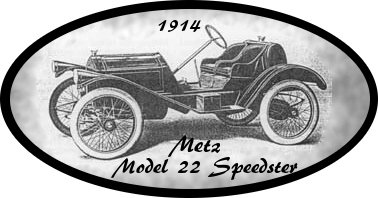
The Metz Company was a pioneer brass era automobile maker established by Charles Herman Metz in Waltham, Massachusetts, from ca.1908 to 1922.
The Early Days - the Waltham Manufacturing Company :

The Metz Company: (the kit car)

When C. H. Metz took over the Waltham Manufacturing Company in 1908, he had significant manufacturing space, a large supply of parts for uncompleted cars, a large debt, and no work force. The agreement was that he pay off $10,000 per month until the debt was paid. His solution, offer to the public the Plan Car (a kit car). This required a minimal work force to make any additional parts needed and to package and ship the groups of parts in installments to customers.
Plan Car Specifications:
Model 22:

Model 22 Mechanical Specifications (All):
Body Style Roadster
The Metz Special:

In 1913 only, the “Metz Special”, a more stripped down version of the standard roadster, was offered at the reduced price of $395 but raised to $445 in several months. It was painted vermillion.

In 1914, the standard roadster was offered with a body modification, a “turtleback” compartment instead of the tool box.

In addition, a sportier speedster was offered at a price of $500. It had wire wheels, was painted bright orange with black fenders, had nickel trim, and for an additional $100 could be equipped with electric lights and an electric starter.
The Glidden Tour:
Metz entered three Model 22 cars in the July 1911 Glidden Tour, to give the car a good road test before full scale production. The Metz team was the only team that arrived at the finish line without a time extension, but failed accumulate enough points for an overall win. In the 1913 Glidden Tour, the Metz cars won with perfect scores and no time extension. Another event that illustrated the toughness of the Metz Model 22 was the trip undertaken by L. Wing who owned a Metz agency in Los Angeles and O. K. Parker, a reporter from Los Angeles. They started from Los Angeles, drove across the desert to the Grand Canyon, drove to the bottom of the Grand Canyon and back up by following an intersecting gorge, and then drove back to Los Angeles. The total trip encompassed 1400 miles which included the 84 miles round trip to the bottom of the Grand Canyon and back over very rough terrain.
Model 25:

The Model 25 Metz was introduced in mid 1915 and was offered in two passenger roadster or touring car form from 1915 through 1917. The roadster was a modification of the Fore door Model 22 roadster introduced in 1915. Changes from the Model 22 included a more rounded radiator, hood, and fenders. The horsepower was increased from the model 22 by increasing the engine bore and a single chain final drive was used instead of the double chains used on the Model 22. Complete electrical accessories including starter, lights, and horn were standard equipment on the Model 25 cars. Some trucks were also made in 1916 on the touring chassis although they were not to popular.
Model A $500 Open express
Model B $550 Same as Model A except equipped with electric starter and lights
Model C $525 Express body with top and side curtains
Model D $575 Same as Model C except equipped with electric starter and lights
Model E $600 Enclosed body with standard electric starter and lights.
Body Style Truck Body
Model 25 Mechanical Specifications:
Model 25 Roadster Specifications:
Model 25 Touring Specifications:
Model 25 Truck Specifications:
The War:
Master 6:

The car was the Metz Master 6, it was completely different from anything Metz had produced before. To meet current competition, the friction drive and chain final drive was replaced by a gear transmission and shaft final drive and the four cylinder engine was replaced by a six cylinder engine. Production lasted until 1921 with prices for the roadster and touring starting at $1495 in 1919 and increasing to $1995 by 1921. A roadster, touring, coupe and sedan were manufactured. However, only about 100 coupes and only one sedan is reported to have been built. The price of the coupe started at $2695 in 1920 and increased to $2795 in 1921 and the price of the sedan was listed as $2895 in 1921.
Master 6 Specifications:
The end:
By 1922, the company was in dire financial condition and was taken over by the Waltham National Bank. They reorganized the company and renamed it the Motor Manufacturers Incorporated of Waltham.
I got interested in the Metz because the former RRVCSDC president (now deceased) Jack Willis once owned a Model 25 Metz.
